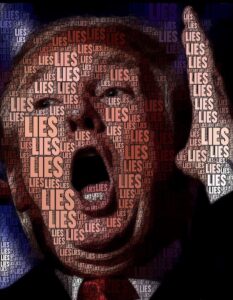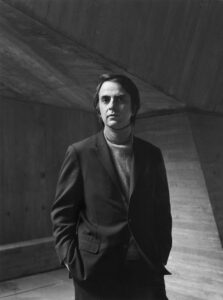In an era of Fake News, the Big Lie, and endless misinformation, we must channel Carl Sagan’s scientific thinking in political discourse to wield a baloney detection kit and uncover truths amid the falsehoods. We need to think about politics scientifically. Indeed, a healthy dose of skepticism is required to navigate the US political landscape and those with a leaning to the scientific worldview will naturally be better equipped that those with a leaning towards the religious worldview.
Those with the religious worldview have been conditioned from childhood to believe in “faith”, resulting in the unquestioning belief in biological absurdities such as a virgin birth and a death and resurrection. Neither of those events ever happened, clearly. And just because a few fanatics living 2000 years ago claimed that it happened is not very good evidence. Consider this: eyewitness testimony in our modern judiciary system is considered flimsy evidence at best because we know how unreliable human memory is and we know common human fallibility is. So one would think that secondary accounts of events that were recorded decades after the event would be considered suspect at best, but to the religious folks, not so much…
In any case, it’s no wonder that these folks are the leading proponents of some of the most ridiculous conspiracy theories in the current US political discourse. If you find a conspiracy nut, it’s a good chance they are a Jesus lover. For those of us who haven’t tumbled down the religious rabbit hole, scientific thinking in political discourse offers a toolkit to sort truth from fiction and expose outright lies. It is imperative that we apply these to the US political landscape because democracy is currently under attack.
The Baloney Detection Kit: Using Scientific Thinking in Political Discourse
Everyone needs a baloney detection kit rooted in scientific thinking for today’s political discourse. Many of these tactics have personally saved me from believing things that may have felt right to me or that I have wanted to believe is the truth, but have ultimately turned out to be false. To keep things simple, I have four rules to always follow when trying to decide fact from fiction from US politicians.
- Bayes’ Theorem – The Bayesian system of thinking is: Initial belief + new evidence = new and improved belief. It is a form of probabilistic thinking used under conditions of uncertainty (which basically applies to every situation you will encounter). The mathematics behind Bayes’ Theorem basically says that if you have an extraordinary hypothesis, it should require extraordinary evidence to convince you that it’s true.
- Occam’s Razor – This is a rule of thumb that when trying to figure out what happened in a situation, the simplest explanation is usually right. Another way of thinking about this is the explanation that requires the *least* amount of coincidences – or special explanations – is usually the right one.
- Debate – Debate is a good thing. Anyone trying to discourage you from debating a topic is probably lying. Science fears no questions. The truth fears no questions. Those who fear questions also fear science and the truth.
- Do not become emotionally attached to an idea or ideology – Be open to the possibility that you might be wrong. Evidence should change your opinion (see Rule #1) If you decide ahead of time that what you believe to be true must be right then you aren’t thinking scientifically, you’re just a religious fundamentalist.
The Improved Baloney Detection Kit
These four rules will serve anyone pretty well most of the time, but of course not 100% of the time. Nothing can reduce uncertainty to zero percent but of course we can always get closer and closer to the truth. In order to take things to the next level I recommend reading Carl Sagan’s classic book Science as a Candle in the Dark. In particular, pay close attention to Chapter 12: The Fine Art of Baloney Detection.
Carl Sagan was a remarkable person who wanted to use science to improve the human condition. May his spirit of skepticism live on.
The kit is brought out as a matter of course whenever new ideas are offered for consideration. If the new idea survives examination by the tools in our kit, we grant it warm, although tentative, acceptance. If you’re so inclined, if you don’t want to buy baloney even when it’s reassuring to do so, there are precautions that can be taken; there’s a tried-and-true, consumer-tested method.
Carl Sagan
Further reading: Science as a Candle in the Dark by Carl Sagan

